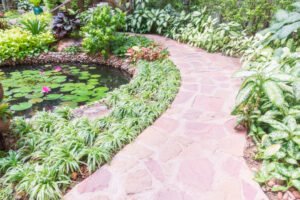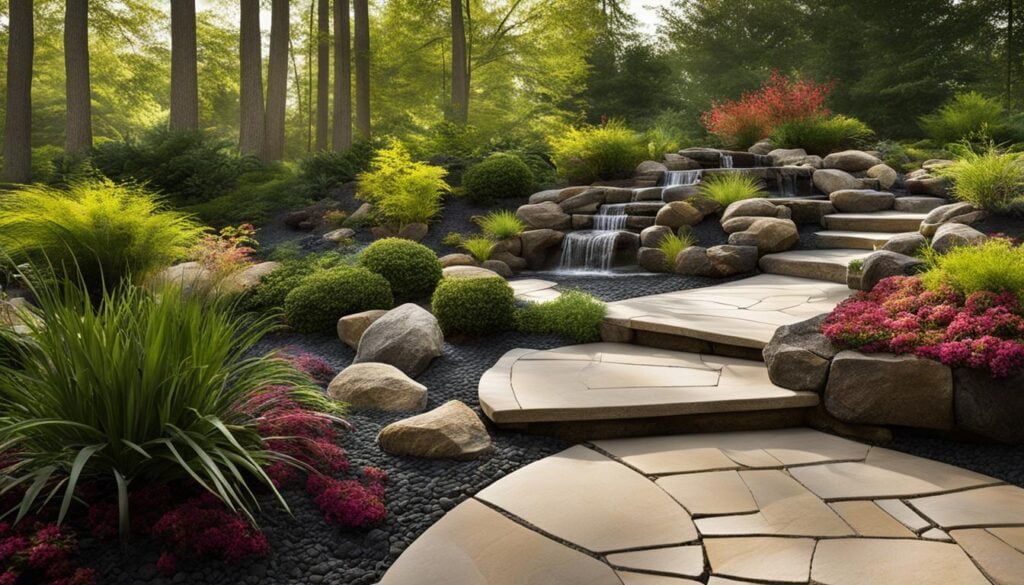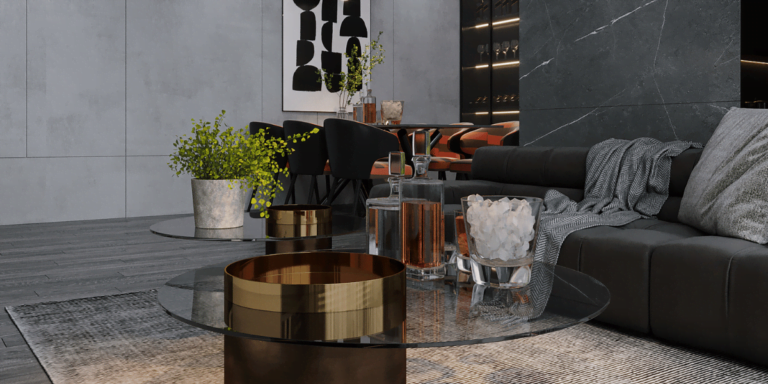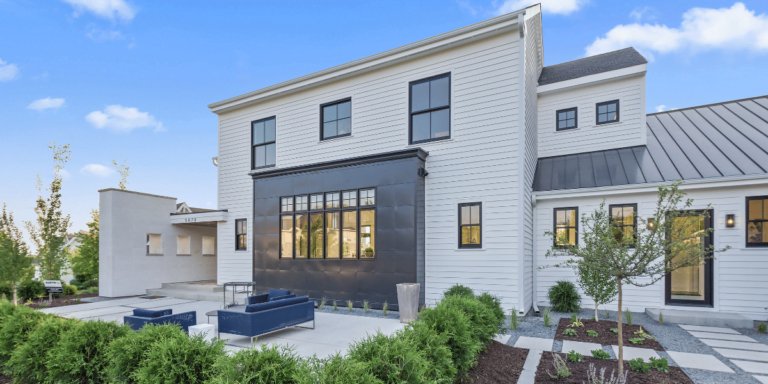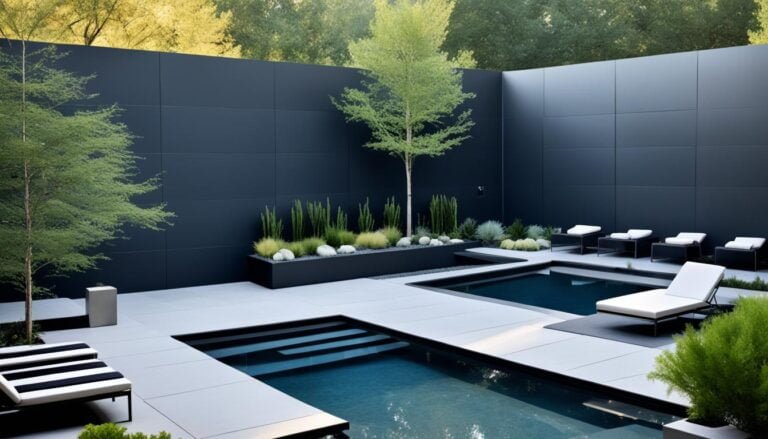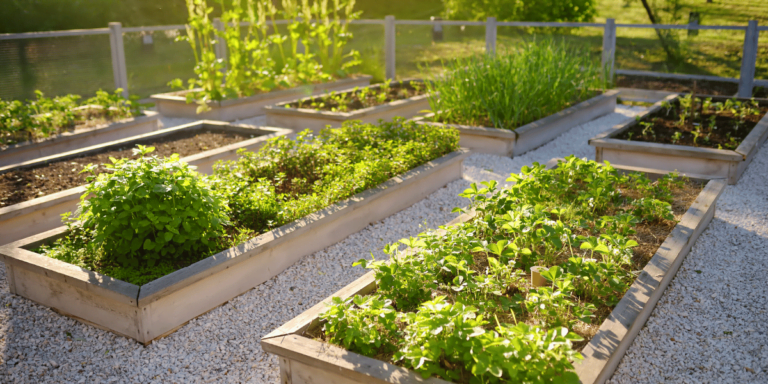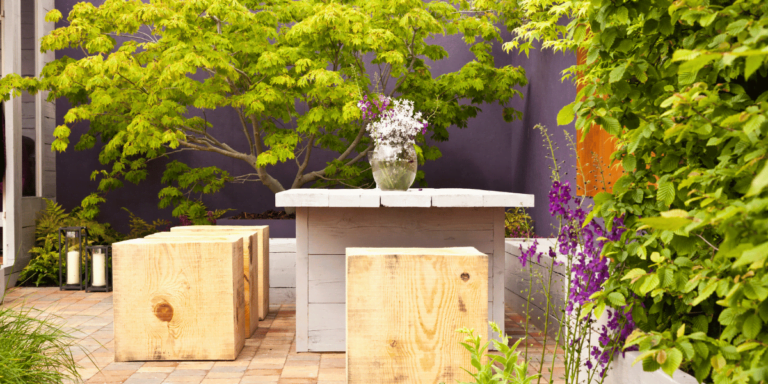Welcome to our guide on holistic garden designs, where we explore the integration of wellness and beauty in outdoor spaces. A serene retreat amidst nature can have a transformative effect on our physical and mental well-being. By incorporating elements that promote relaxation and cultivate a sense of harmony, you can create a holistic garden that enhances your overall wellness.
Key Takeaways:
- Creating a healing garden at home can help reduce stress and improve well-being.
- Setting clear goals for your garden design can prioritize features that address specific healing needs.
- Incorporating hardscape elements, such as paths and patios, can enhance the serene environment.
- Providing seating areas and attracting wildlife can contribute to the holistic experience.
- Holistic garden designs offer numerous benefits, from sustainable practices to eco-friendly landscape design.
Establishing Goals for Your Healing Garden
When designing a healing garden, it is crucial to establish clear goals that align with your specific needs and aspirations. By defining these objectives, you can create a garden space that truly caters to your health concerns and limitations.
Healing gardens can be broadly classified as either restorative gardens or enabling gardens, each offering unique benefits and experiences. Restorative gardens are designed to facilitate passive activities such as walking, healing contemplation, or simply finding solace in nature’s embrace. On the other hand, enabling gardens focus on promoting active engagement through gardening, which provides therapeutic benefits.
Consider your health concerns and limitations. Are you seeking a place of tranquility that nurtures peace and relaxation? Or do you aspire for a more interactive garden that engages you physically and mentally? Identifying your goals will help you determine the type of healing garden that would best serve your needs.
Once you have established your goals, it is essential to prioritize design features that align with your objectives. This thoughtful selection ensures that your healing garden caters to your specific healing needs and accommodates any potential limitations of visitors or gardeners.
Comparing Restorative and Enabling Gardens
| Restorative Gardens | Enabling Gardens |
|---|---|
| Passive activities such as walking, sitting, and contemplation | Active engagement through gardening activities |
| Emphasis on tranquility and relaxation | Emphasis on physical and mental stimulation |
| Designed for individuals seeking solace and stress relief | Designed for individuals looking for interactive therapy |
| Promotes rejuvenation and restoration of well-being | Fosters personal growth and empowerment through gardening |
Establishing goals for your healing garden allows you to personalize the space and create a harmonious environment that enhances your well-being. Whether you prioritize tranquility and reflection or prefer active engagement and growth, your garden design can be tailored to meet your unique needs.
Next, we will explore how to incorporate various elements to create a serene and therapeutic atmosphere in your healing garden.
Incorporating Elements for a Serene Environment
To create a serene environment in your holistic garden, it is essential to consider the design of hardscape elements. These elements provide structure and define the various areas of your garden. By incorporating paths and patios, you can create a cohesive flow and connect different spaces within your garden.
Paths and patios offer both functionality and aesthetic appeal. They not only guide visitors through your garden but also provide designated areas for relaxation and socializing. Surround these paths and patios with lush planting beds, filled with beautiful flowers, shrubs, and trees, to create a harmonious blend of hardscape and softscape elements.
Designing Accessible Paths
It is important to consider the needs of all garden visitors, including those with mobility challenges. Ensure that your paths are wide enough to accommodate wheelchairs, walkers, or strollers. By designing accessible paths, you create a welcoming space that can be enjoyed by everyone.
Creating Privacy with Walls
Privacy walls can be integrated into your holistic garden design to create a sense of seclusion and tranquility. These walls can serve as a visual barrier while also providing protection from wind or noise. Choose materials that complement the overall aesthetic of your garden, such as wood, stone, or trellises adorned with climbing plants.
Enjoy the Soothing Sound of Water
A water feature is a wonderful addition to any garden, as it adds a sense of serenity and relaxation. Consider incorporating a rock bubbler or a pond into your holistic garden design. The gentle sound of trickling water can create a calming ambiance and mask unwanted noises from the surrounding environment.
Illuminate Your Garden with Lighting
Proper lighting is crucial for not only safety but also creating a soothing atmosphere in your garden. LED lights can be strategically placed to highlight particular plants or paths, creating an enchanting nighttime display. Soft, warm-toned lighting helps to create a cozy and inviting atmosphere, perfect for enjoying your garden even after the sun has set.
Enhancing Wildlife Habitat and Seating Opportunities
A holistic garden should provide opportunities for wildlife to thrive, as their presence can contribute to the healing energy. Attracting wildlife to your garden can be achieved by incorporating various elements that create a welcoming habitat.
Attracting Wildlife Holistic Garden Designs
One way to attract wildlife is by installing birdhouses, birdfeeders, and birdbaths. These not only provide shelter and nourishment for birds but also attract butterflies and beneficial insects. Choose birdhouses and feeders that are suitable for the bird species in your area, and keep them well-maintained.
Another important factor in attracting wildlife is the selection of plants. Opt for native plants that provide nectar, food, and habitat for local wildlife. Some examples include Joe-Pye weed, purple coneflowers, and asters. These plants not only add beauty to your garden but also serve as a food source for butterflies and hummingbirds.
Seating Areas
Seating areas in your holistic garden allow you to relax and observe the beauty of nature. Placing comfortable seating options strategically throughout the garden provides opportunities for quiet reflection and stress reduction.
| Seating Options | Description |
|---|---|
| Bench | A classic choice that fits well in any garden. Opt for a weather-resistant material like teak or cedar. |
| Lightweight Chairs | Easy to move around and ideal for smaller spaces. Look for chairs made from durable materials like aluminum or synthetic wicker. |
| Comfortable Chair, Hammock, or Glider | Amp up the relaxation factor with a cozy chair, a hammock for ultimate comfort, or a glider for gentle motion. |
To create a serene retreat within your seating area, consider adding curtains for privacy, an outdoor bookshelf for your favorite reads, or a blanket box to cozy up during cool evenings. Furthermore, lighting candles or lanterns can add a warm and inviting ambiance to your outdoor space.
By incorporating attracting wildlife elements and comfortable seating areas, your holistic garden will become a haven for both nature and your well-being.
Conclusion
Holistic garden designs offer numerous benefits, blending aesthetics with personal well-being. These gardens provide a serene retreat where people can connect with nature and experience positive changes in their physical and mental health. By integrating sustainable practices, eco-friendly landscape design principles, and incorporating elements that attract wildlife, a holistic garden can become an oasis of wellness. Whether you have a small balcony or a spacious yard, everyone can create a healing garden that brings beauty and wellness together.
Sustainable urban gardening is a key aspect of holistic garden designs. By implementing practices like composting, rainwater harvesting, and using organic fertilizers, you can minimize the environmental impact of your garden. Eco-friendly landscape design focuses on creating a harmonious balance between the built environment and nature, using native plants, reducing water consumption, and promoting biodiversity. These sustainable practices not only benefit the environment but also contribute to the overall well-being of the garden and its visitors.
In addition to sustainable practices, attracting wildlife to your garden is another important element of holistic design. By incorporating birdhouses, feeders, and birdbaths, you can create a habitat that supports diverse species and promotes ecological balance. These interactions with nature enhance the sense of tranquility and connection to the natural world. As you spend time in your holistic garden, you will reap the benefits of improved mental clarity, reduced stress, and a heightened sense of peace.
In conclusion, holistic garden designs provide a holistic approach to well-being, combining aesthetics, sustainability, and wildlife-friendly elements. Whether you are an urban dweller with limited space or have a sprawling yard, you have the opportunity to create a beautiful and eco-friendly garden that promotes your physical and mental wellness. Embrace sustainable urban gardening, eco-friendly landscape design, and holistic garden benefits to transform your outdoor space into a serene retreat that nourishes your body, mind, and soul.
Frequently Asked Questions
What are some benefits of creating a holistic garden?
A holistic garden provides a serene retreat where people can connect with nature, reduce stress, and experience positive changes in their physical and mental health.
How can I determine the type of healing garden to create?
Consider your health concerns and limitations, and use your goals as a guide to prioritize design features that address specific healing needs and accommodate the limitations of the visitor or gardener.
What elements should I incorporate to create a serene environment in my holistic garden?
Consider adding hardscape elements such as paths and patios, privacy walls, water features, and lighting to enhance relaxation and create a soothing ambiance.
How can I attract wildlife to my healing garden?
Incorporate birdhouses, birdfeeders, and birdbaths to attract butterflies, birds, and insects. Choose plants that provide nectar and food, and create seating areas where you can observe the beauty of nature.
How can I integrate sustainability and eco-friendly design principles in my holistic garden?
You can practice sustainable urban gardening, use eco-friendly landscape design techniques, and incorporate elements that attract wildlife to create a vibrant and environmentally-friendly garden.

